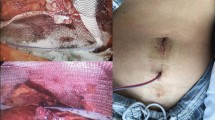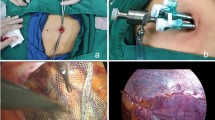Abstract
Objectives
Seroma is a virtually unavoidable early sequela after TEP hernioplasty. This randomised controlled trial evaluated the outcomes of preperitoneal closed-system suction drainage in laparoscopic totally extraperitoneal (TEP) hernioplasty for inguinal hernia.
Methods
Ninety patients aged 18–80 years who presented to our hospital between May 2016 and February 2017 with primary unilateral inguinal hernia were randomised into the preperitoneal drain and no-drain groups. The primary outcome was seroma size on postoperative day 6. Secondary outcomes included clinical seroma formation and seroma size on day 1, day 6, 1 and 7 months postoperatively, length of postoperative stay, pain score, and recurrence.
Results
There was no significant difference in age, sex, co-morbidities, hernia side, mean hernia size, operating time, fixation adjuncts, or postoperative stay. The overall incidence of clinical seroma formation was 25.6% on postoperative day 1, 60.3% on postoperative day 6, 13.2% 1 month and 0% 7 months postoperatively. The mean drain output was 57.9 ml. The drain group had significantly fewer patients with seroma on day 1 (6 vs 14, p = 0.022) and day 6 (17 vs 30, p = 0.000), and a smaller mean seroma size on days 1 and 6 (p = 0.000). Subgroup analysis showed that sac ligation versus reduction, peritoneal perforation, and fixation adjuncts had no significant effects on seroma formation or size. There is a trend of lower early post-operation VAS score and more urinary retention in drain group was observed but not reaching statistical significance. No differences in postoperative pain score or complications were observed at 1 and 7 months’ post operation.
Conclusions
Preperitoneal drainage for 23 h after laparoscopic TEP hernioplasty for inguinal hernia can effectively decrease seroma formation in the early postoperative period, and potentially improving postoperative pain. The benefit is short-term and no significant difference was demonstrated after 1-month post operations. This tradition technique applied to novel operative repair of inguinal hernia is safe and feasible with no significant morbidity demonstrated. Preperitoneal drainage after TEP can be considered as an option to improve patient satisfactions and recovery in selected patient group for maximal benefit, especially for those with prolonged operation which may associate with higher chance of seroma formation.






Similar content being viewed by others
References
Bittner R et al (2011) Guidelines for laparoscopic (TAPP) and endoscopic (TEP) treatment of inguinal hernia [International Endohernia Society (IEHS)]. Surg Endosc 25(9):2773–2843
Bittner R, Schwarz J (2012) Inguinal hernia repair: current surgical techniques. Langenbecks Arch Surg 397(2):271–282
Wauschkuhn CA et al (2010) Laparoscopic inguinal hernia repair: gold standard in bilateral hernia repair? Results of more than 2800 patients in comparison to literature. Surg Endosc 24(12):3026–3030
Fan JK et al (2017) Randomized trial comparing self gripping semi re-absorbable mesh (PROGRIP) with polypropylene mesh in open inguinal hernioplasty: the 6 years result. Hernia 21(1):9–16
She WH et al (2011) Needlescopic totally extraperitoneal hernioplasty for unilateral inguinal hernia in adult patients. Asian J Surg 34(1):23–27
Wada H et al (2012) Laparoscopic transabdominal preperitoneal inguinal hernia repair using needlescopic instruments: a 15-year, single-center experience in 317 patients. Surg Endosc 26(7):1898–1902
Wijerathne S et al (2014) A prospective randomized controlled trial to compare single-port endo-laparoscopic surgery versus conventional TEP inguinal hernia repair. Surg Endosc 28(11):3053–3058
Tran H (2011) Safety and efficacy of single incision laparoscopic surgery for total extraperitoneal inguinal hernia repair. JSLS 15(1):47–52
Krishna A et al (2012) Laparoscopic inguinal hernia repair: transabdominal preperitoneal (TAPP) versus totally extraperitoneal (TEP) approach: a prospective randomized controlled trial. Surg Endosc 26(3):639–649
Lopez-Monclus J et al (2012) Persistent inguinal seroma managed with sprinkling of talcum powder: a case report. J Med Case Rep 6:391
Berney CR (2012) The Endoloop technique for the primary closure of direct inguinal hernia defect during the endoscopic totally extraperitoneal approach. Hernia 16(3):301–305
Beacon J, Hoile RW, Ellis H (1980) A trial of suction drainage in inguinal hernia repair. Br J Surg 67(8):554–555
Rodrigues AJ Jr et al (2003) The Stoppa procedure in inguinal hernia repair: to drain or not to drain. Rev Hosp Clin Fac Med Sao Paulo 58(2):97–102
Peiper C et al (1997) Value of subcutaneous drainage in repair of primary inguinal hernia. A prospective randomized study of 100 cases. Chirurg 68(1):63–67
Ismail M et al (2009) Impact of closed-suction drain in preperitoneal space on the incidence of seroma formation after laparoscopic total extraperitoneal inguinal hernia repair. Surg Laparosc Endosc Percutan Tech 19(3):263–266
Gao D et al (2015) Clinical research of preperitoneal drainage after endoscopic totally extraperitoneal inguinal hernia repair. Hernia 19(5):789–794
Bittner R et al (2015) Update of guidelines on laparoscopic (TAPP) and endoscopic (TEP) treatment of inguinal hernia (International Endohernia Society). Surg Endosc 29(2):289–321
Acknowledgements
The authors thank ZL; GZ; HZ; JL; JW; JS for assisting with creation of a database and patients care. Expert advice from Prof Anil.Sharma. is greatly acknowledged.
Funding
No funding was received for conducting this trial.
Author information
Authors and Affiliations
Contributions
JKMF—Original idea, data analysis, preparation of manuscript, critical revision of manuscript; JL—data collection and follow-up of patients; KC—data collection and follow-up of patients; XX—data collection and follow-up of patients; HKC—critical revision of manuscript; FSYC—original idea, Critical revision of manuscript; KWHC—data collection and follow up of patients; CML—critical revision of manuscript.
Corresponding author
Ethics declarations
Conflicts of interest
JKMF declare no conflict of interest; JL declare no conflict of interest; KC declare no conflict of interest; XF declare no conflict of interest; XX declare no conflict of interest; HKC declare no conflict of interest; FSYC declare no conflict of interest; KWHC declare no conflict of interest; CML declare no conflict of interest.
Ethical standard
All procedures involving human participants were performed in accordance with the ethical standards of our institutional research committee and the study was conducted according to the ethical standards of the Helsinki Declaration of 1975.
Human and animal rights
This article does not contain any studies with animals performed by any of the authors.
Informed consent
Informed consent was obtained from all individual participants included in the study after detail explanation of possible complications. Patients were then given at least 24 h for consideration of participating in the clinical trial before operation.
Rights and permissions
About this article
Cite this article
Fan, J.K.M., Liu, J., Chen, K. et al. Preperitoneal closed-system suction drainage after totally extraperitoneal hernioplasty in the prevention of early seroma formation: a prospective double-blind randomised controlled trial. Hernia 22, 455–465 (2018). https://doi.org/10.1007/s10029-018-1731-2
Received:
Accepted:
Published:
Issue Date:
DOI: https://doi.org/10.1007/s10029-018-1731-2




